As I’m going to reprint some Aboriginal art images in this blog post, I need to caution that some Aboriginal people prefer not to see art by their people reproduced, particularly if the artist is deceased. So be warned, and don’t view this post if you’re sensitive to these issues.
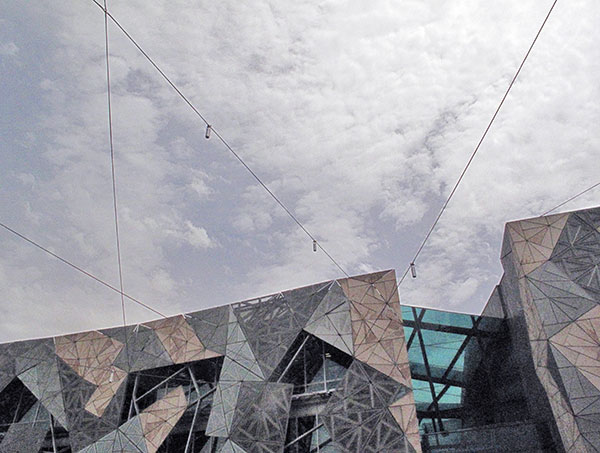
The heart of Melbourne holds a large art museum complex in what’s called Federation Square. All the buildings in the complex are patterned with irregular Penrose-like tiles on the outside. We saw some galleries of wonderful Aboriginal (they often say “indigenous” as well) paintings inside the NGV (National Gallery of Victoria) here. Many of these are super-pointillist and somewhat abstract-looking, they’re made from dots which are sometimes painted on with sticks or with Q-tips with the cotton torn off.
Many of these pictures have a story or a “Dreaming” associated with them, although the story isn’t at all apparent to the untutored eye. Many of the pictures are also in some sense topographical, mapping out the geographical patterns, the practical uses, the spiritual vibes, or the mythic tales associated with regions where the painters live.

[“Rockholes and Country Near the Olgas,” 2007, by Kumanara “Bill Whiskey” Tjalpaltjarri. Click for larger version.]
One topographical picture that I liked was by the artist commonly called Bill Whiskey Tjalpaltjarri (1920-2008), “Rockholes and Country Near the Olgas,” painted in 2007, when Kumanara was 87 years old. So far as I know, he used this same title for all of his pictures. A rockhole is, I believe, a water hole. In this work, The dots bunch up here and space apart there, like windblown fog, several layers deep, and he does subtle things with the colors like having dark blue dots upon black ones. It was a very long picture, and reminiscent, in its own way of David Hockney’s “Mulholland Drive.” I worship this picture by Kumanara Tjalpaltjarri, I went back to look at it three times—my patched together photo doesn’t do it justice.
It would be fun to make a topographical map of my own neighborhood and home town as seen from above, using patterns and colors to show some of the things I’ve experienced on this familiar home territory. I don’t think I’d have the patience to use dots, but maybe I could use some other kinds of small patterns.
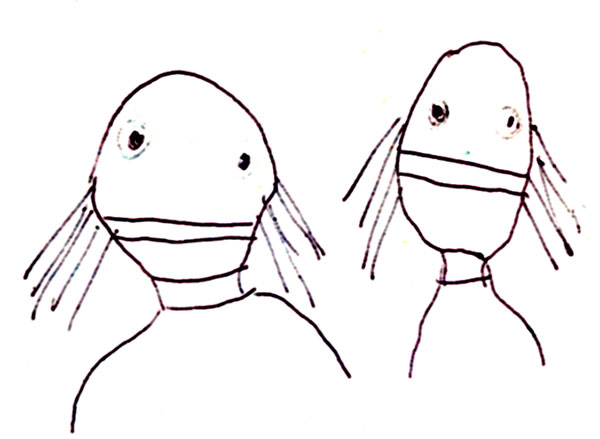
[I didn’t manage to get a photo of Yirawala’s work, but I made a rough pocket sketch of his “Mardayin Ceremony” of 1979, seen in the National Gallery of Victoria.]
I was also stuck by some large drawings done with “earth on stringy bark” in Marrkolidjban, in the Northern Territory. Stringy bark is bark from a peeling eucalyptus tree, somewhat like the euc we happen to have in our yard back in CA. The artist, Yirawala , is one of the most famous of the Aboriginal bark artists, and is sometimes compared to Picasso.
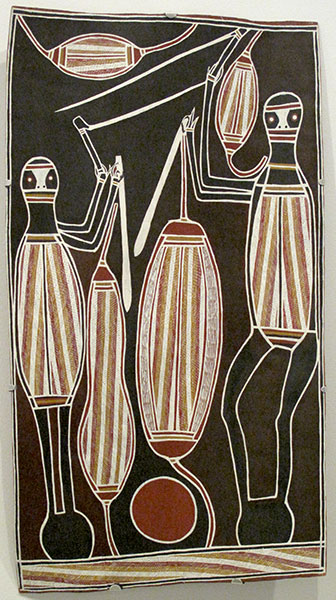
[“Two Tunmirringu Fighting,” Bark painting by David Malangi, Arnheim Land (an area on the north coast of Australia), seen at the Gallery of New South Wales.]
It’s interesting how hard it is for most of us, as adults, to draw in the diagrammatic style that we used as children. And then we labor to get back to that clarity. It’s like the Aboriginal artists have short-circuited the whole process of primitive-to-advanced-to-primitive. Artistically speaking, they’re still in the Garden of Eden.
Long story short: in the West, we started with ideograms and abstractions, got realistic, and tried to get back to the ideograms. In Australia they stuck with ideograms…and got really good at it.
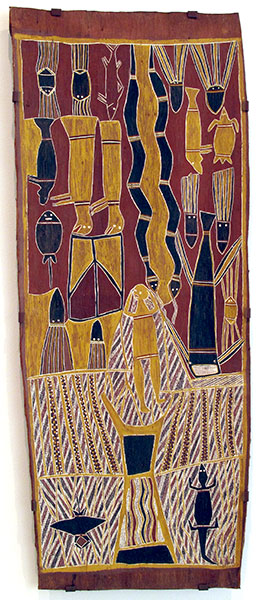
[“Thunder Spirits (Birimbira)” by Munggurrawuy Yunupingu , 1861, Arnheim Land, seen in the Gallery of New South Wales in Sydney. Dig those jellyfish with the dangling tendrils.]
During our trip, Sylvia and I also went to some commercial galleries selling Aboriginal art. One of them, the Gallery Gabrielle Pizzi in Melbourne, was particularly good, up on the third floor of a downtown building like a classy New York gallery. Check out the “Paintings” section of their “Online Gallery,” I have a screen capture below.
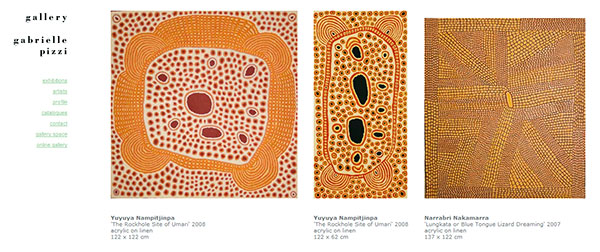
The pictures were selling for about $10K; many of their painters live in the middle of Australia, east of Ayers Rock. One work, by Kim Napurrula, who paints with the Papunya Tula art movement, impressed me particularly, although I don’t have a good photo of it. It was like a great abstract painting, but with a vital sense of there being an underlying story. Wonderful colors, all in shades of red, orange, beige, yellow, brown, and black. Kim is from a family of Aboriginal painters, it seems to be a kind of passed-on craft, as painting was in Europe in the Middle Ages.
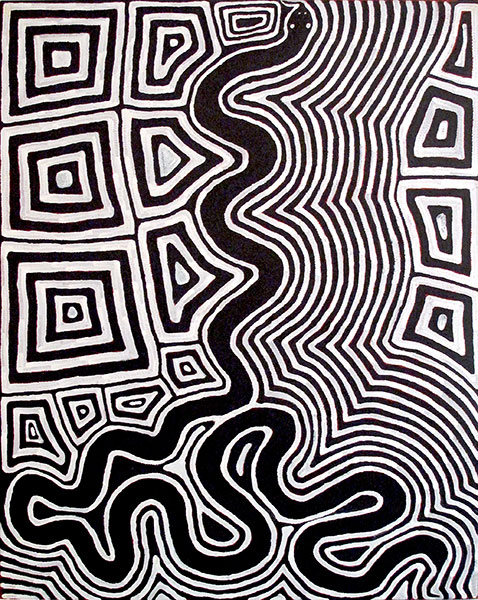
[“Tingan Motifs and Snake,” by Ronnie Tjampitjinpa, who’s very popular. Seen in the Gallery of New South Wales.]
In Sydney we visited the Art Gallery of New South Wales, a museum which lies in a huge city park. Their display of Aboriginal art was just amazing. I’ve learned that the Aboriginals of Australia are maybe the oldest continuous civilization on Earth—they went along doing more or less the same thing for 60,000 years, the Aborigines, and they have some very elaborate belief systems. The art is still very much alive—I’m still having trouble understanding the sociology of how it’s created—it’s quite different from in the U.S.
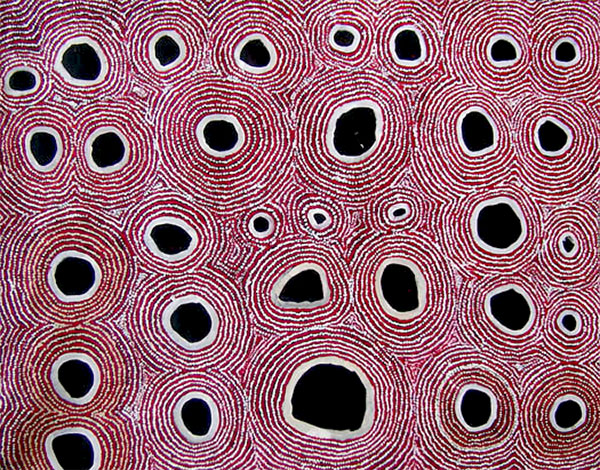
[Painting by Simon Hogan, 2009. Shown as part of the “Tracking the Wati Kutjara – Spinifex 2009” show, photo (C) Cooee Aboriginal Art Gallery. Here’s a link to page with all the pictures in the show]
We saw some more Aboriginal art in the wonderful Cooee Aboriginal Art Gallery in Bondi, near Sydney. I was quite interested in the work, and the owner, Adrian Newstead, talked to us for a long time. He showed us pictures of the artists at work, he goes out to Western Australia to hang with them. Their current show is from the “spinifex” region of the desert—spinifex being an Australian plant—Adrian showed us a picture of the artist Simon Hogan working on the picture shown above. .
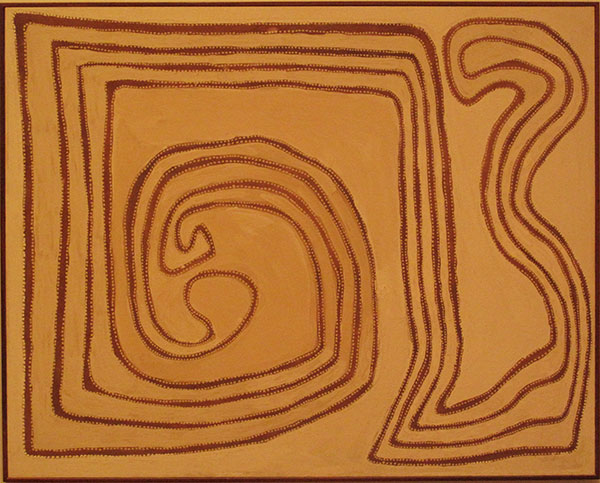
[Rover Thomas, “Dreamtime Story of the Willy Willy,” 1989, a painting of the path of a desert whirlwind, at the National Gallery of Victoria in Melbourne.]
I find it so cool that the Aboriginal art pictures, which look abstract really are, in a sense, representational, depicting, as I mentioned above, specific home territories of the artists. According to the notion of the “Dreaming,” supernatural beings emerged (and are still emerging), and these creatures follow specific paths across the length and breadth of Australia. These paths are called songlines, in part because different tribes at different spots along the line will have a song about a part of the supernatural being’s history. As the Aborigines used no written language, the songs and the graphic designs they make served as their recorded history.
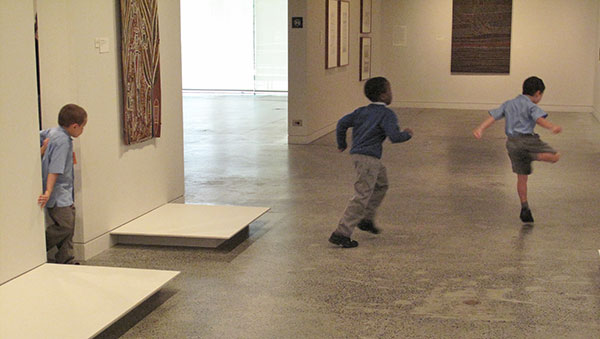
[Kids on a school tour in the Sydney Gallery of South Wales.]
The whole deal of Aboriginal Art is really different, and I’m still figuring it out, reading three books on it right now. One of the books is art-historical: Howard Morphy, Aboriginal Art (Phaidon, London, 1998). The second is a journalistic account of the recent uptick in the market for Aboriginal art, and about the odd ways in which it’s produced and marketed: Benjamin Genocchio, Dollar Dreaming (Hardie Grant, Australia, 2008).
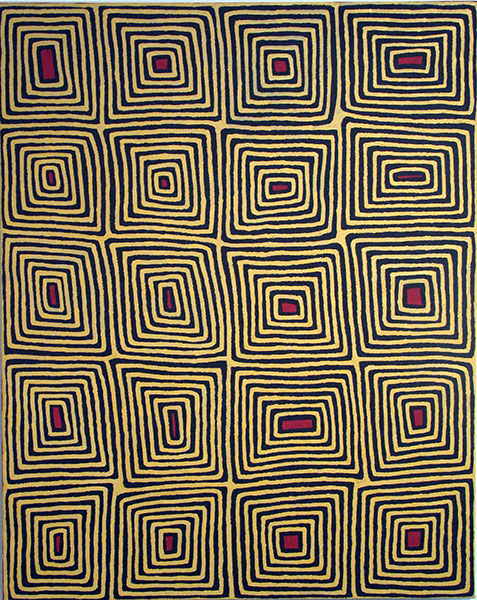
[Antoher painting by Ronnie Tjampitjinpa, in the Gallery of New South Wales. Ronnie’s work is easy on the Western eye, it’s at a nice funky nexus between Aboriginal art and Op art.]
As I understand it, in the 1960s some enlightened forces within the Australian government had the idea of giving the Aboriginal people art materials and promising to buy any and all paintings that they made. And, as happens, some small percentage of the people have turned out to be great artists. Of course any number of the painters are not all that artistically gifted, and the more touristy art galleries are showing art that’s not so good.
The third volume I’m reading is a memoir or travel book by Bruce Chatwin, The Songlines (Vintage, London 1998), and is the most literary of the three. It’s beautifully written and has some profound theories about Aboriginal culture.
One minor flaw I found in The Songlines is that the white female characters seem rather bland and interchangeable. But the the white males and the Aborigines are quite sharply limned and colorful. Another odd thing about the book is that, about half-way through, Chatwin seems to run out of material—and fills most of the second half with pasted in excerpts of his old writing journals. And the old journal entries don’t have any obvious relationship at all to Aboriginal culture. But I suppose Chatwin would have compared his compositional trick to intersecting two mythic songlines in the Australian outback. In any case, it’s a wonderful book.









December 28th, 2009 at 7:16 pm
Merry Christmas and almost Happy New Year from Cousin Nita(Nellie Rucker’s daughter in Oregon). Amazing coincidences- Brother Peter is in Bali and my daughter Nellie is in New Zealand working with WWOOF(Willing Workers on Organic Farms). I looked up your blog and saw that you are in Australia. Nellie goes over to Sydney for a few days(so that she can renew a visitor’s visa to New Zealand). I will tell her to look up your blog which is amazing in the information that you give about your trip to Australia. Good hazelnut harvest this year. All 4 of the Walter children are alive and well. Henry turns 70 in January. Cousin Nita